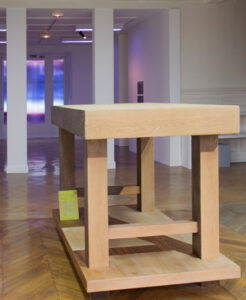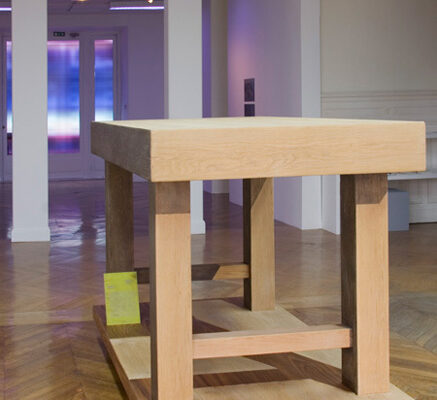Bettina Samson, L’établi de Becquerel, lettre de son futur 2008
Sculpture, placage de chêne et noyer noir sur bois, plaque électronique gravée et étamée, 116 x 194 x 140 cm
Bettina Samson, L’établi de Becquerel, lettre de son futur 2008
Sculpture, placage de chêne et noyer noir sur bois, plaque électronique gravée et étamée, 116 x 194 x 140 cm
L’établi de Becquerel, lettre de son futur constitue une réplique surdimensionnée de l’établi du scientifique. Réalisé à partir d’une image montrant Becquerel posant à ses côtés, l’objet est ici érigé comme symbole – voire comme monument propulsé depuis le passé, immuable – au même titre que sa propre ombre, signalisée et matérialisée par la marqueterie. Reposant contre l’un de ses pieds, une plaque jaune translucide gravée recto verso en lettres d’argent attire le regard : il s’agit de la lettre qu’Albert Einstein envoya au président Franklin Roosevelt en 1939 afin de l’inciter à déclencher le Projet Manhattan, lequel conduisit à la conception, la production et l’explosion de trois bombes atomiques en 1945. L’artiste juxtapose ici deux éléments de manière anachronique, créant ainsi une ellipse temporelle interrogeant les notions d’« avancée » scientifique et de fait historique.
Anne-Lou Vicente
Texte paru dans le journal de l’exposition Bettina Samson au centre d’art La Galerie de Noisy le Sec
http://www.documentsdartistes.org/artistes/samson/repro16-2.html
Here a series of big black and white film photographs overlooking an outsized workbench represent the outcome of a home-made scientific experiment: artist Bettina Samson has set out to recreate the chance situation leading Henri Becquerel’s discovery of radioactivity in 1896, when he found that uranium left an imprint on photographic plates without the need for any light input. Working in total darkness, Samson exposed sheet film to the radiation of pitchblende, a form of uranium ore, and obtained near-immaterial images which, enlarged, suggest some kind of astronomical phenomenon. Can photos be made without visible light? This process recalls the pioneering use of silver-salts photography as a scientific tool and the way the resultant images were later echoed in abstract painting. Chance and error are both dynamic principles within scientific and artistic research, sharing as they do the same experimental dimension. In the middle of the room there stands, like a monumental tribute to “decisive fortuity”, a stylised marquetry transposition of the scientist’s oak workbench, a near relative of the tradesman’s. Our reading of the work, however, is disturbed by the presence of a translucent yellow plaque with silver letters etched into it, a transcription of the 1939 letter from Albert Einstein to Franklin Roosevelt that triggered the Manhattan Project for an atomic bomb. This ellipsis between two past events highlights the provisional character of our certainties as a factor that renders the notion of scientific progress distinctly problematic.
Text by Pedro Morais in Bettina Samson, Laps & Strats, edition Adera, Lyon, 2009.

